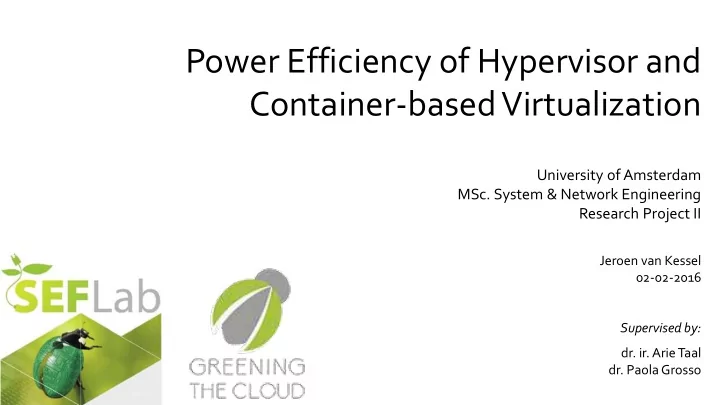

Power Efficiency of Hypervisor and Container-based Virtualization University of Amsterdam MSc. System & Network Engineering Research Project II Jeroen van Kessel 02-02-2016 Supervised by: dr. ir. Arie Taal dr. Paola Grosso
Significance • Growing consumption of cloud services Cisco claims: "by 2019 , more than 86 percent of all workload will be processed by cloud data centers " • More awareness on power consumption • Container-based virtualization is an emerging technology Docker became very popular in a relative short time 2/26
Related Work (1) • Van der Poll [2015] - Power consumption of two open-source hypervisors , KVM and Xen - KVM as a more green solution than Xen . • IBM research division [2014] - Performance comparison of virtual nodes ran by a hypervisor versus Linux containers - Docker had equal or faster performance compared to KVM • Ericsson research division [2015] [1] Empirical Investigation of power consumption of virtualization platforms - Compared number of VMs and Containers - Power impact of CPU, memory and HDD - Used a Power Measurement Device - Results: virtualization platforms behave similarly in idle state and in CPU/Memory stress test Figure 1: Power Measurement Device Image source: http://media.bestofmicro.com/green-power-cpu-performance,E-0-228600-13.jpg 3/26
Related Work (2) • Ericsson research division [2015] [2] - Performance comparison between traditional hypervisors and Linux containers - Containers achieve generally better performance compared to traditional VMs Figure 2: LINPACK CPU performance Source: Ericsson, Hypervisors vs. Lightweight Virtualization: a Performance Comparison [2015] 4/26
Research Question (1) Is there a difference in power efficiency under a traditional hypervisor-based virtualization versus Linux containers ? 5 /26
VMs and Containers • Container virtualization is a lightweight alternative to hypervisor-based virtualization • Container runs on top of the same shared host OS kernel • While VMs install a full Guest OS • Containers do not isolate resources as well as hypervisors Xen 4.5.1 Docker 1.9.1 6 /26 Figure 3: Image source: http://gordonsun-blog.s3.amazonaws.com/wp-content/uploads/2015/05/docker-containers-vs-vms.png
Approach Figure 4: Power Measurement Setup 7 /26
Measurement Setup Table 1: IBM 1U Server Specifications Running Ubuntu 15.10 x64 8 /26
9 /26
Measurement Sensors (1) Power Usage Sensor (2) Data Acquisition Interface Board 11 /26 Image source: eurocircuits.com blueprints
Measurement results Synthetics Applications Table 2: Dominant components and their synthetics benchmark applications But first, IDLE is measured as a baseline 12 /26
IDLE Power consumption (1) 9 7.73 8 7.39 7.27 6.91 Average Power Usage in Watt (W) 7 6.63 6.56 6 4.93 4.87 4.86 5 4 3 2 1 0 Xen running 1 Virtual Node Docker running 1 Container Native OS CPU Memory HDD 13 /26
Total IDLE Power consumption (2) 19.57 20 18.88 18.68 18 4.93 4.87 4.86 16 Total Power Usage in Watt (W) HDD 14 12 6.91 6.63 6.55 10 Memory 8 6 4 CPU 7.73 7.27 7.38 2 0 Xen running 1 Docker running 1 Native OS Virtual Node Container 14 /26
CPUs and Cores CPU1 CPU2 Experiment 1: 4 cores on CPU1 CPU1 CPU2 Experiment 2: 2 cores both CPU1 and CPU2 15 /26 Image source: http://img.tomshardware.com/us/2007/10/29/hitting_4ghz_with_air_cooling/intel_penryn_45_nm_octo_core.jpg
Power Consumption during LINPACK on Docker (1) and Xen (2) 1 2 3 (1) Docker : All 4 cores used on physical CPU1 (2) Xen : All 4 cores used on physical CPU1 16 /26
Power Consumption during LINPACK on Docker (1) and Xen (2) (1) Docker : 2 cores used of each CPU1 and CPU2 (2) Xen : 2 cores used of each CPU1 and CPU2 17 /26
Total Power consumption of LINPACK CPU Docker and Xen 18 /26
Energy efficiency during LINPACK (CPU intensive) 1800 1581 1502 1600 1397 1341 1400 Power Efficiency in MFLOPS / W 1200 1000 800 600 400 200 0 19 /26 Xen 1 CPU Xen 2 CPUs Docker 1 CPU Docker 2 CPUs
Power Consumption during sysbench 350GiB memory transfer Power Usage of all memory banks (1) Power Usage of all memory banks (2) 20 /26
Total Power efficiency during a sysbench 350GiB memory transfer 120.000 104.411 101.560 100.661 100.000 Power Efficiency in (Ops/sec) / W 80.000 60.000 40.000 20.000 0.000 Xen Memory Docker Memory Native OS Memory 21 /26
Power Consumption during Bonnie++ (25GiB) 22 /26
Total Power efficiency during Bonnie++ 25GiB (Sequential Writes in Kb/sec) 14.000 12.252 12.140 11.555 12.000 Power Efficiency in (Kb/sec) / W (Sequential Write) 10.000 8.000 6.000 4.000 2.000 0.000 Xen HDD Docker HDD Native OS HDD 23 /26
Conclusion Research question: Is there a difference in power efficiency under a traditional hypervisor-based virtualization versus Linux containers? Performance results match with the Ericsson research Power Efficiency results: CPU: Docker is more efficient in terms of power Memory, HDD (Writes) and IDLE: Docker is more efficient but almost negligible 24 /26
Future Work • Benchmark multiple virtual nodes and containers • Investigate the energy footprint of the network component • Test other applications Performance evaluation of real life applications • Futher investigation of other platforms such as LXC, KVM and VMware • Investigate energy impact of (Xen) Paravirtualization 25 /26
Thanks for your attention
Recommend
More recommend